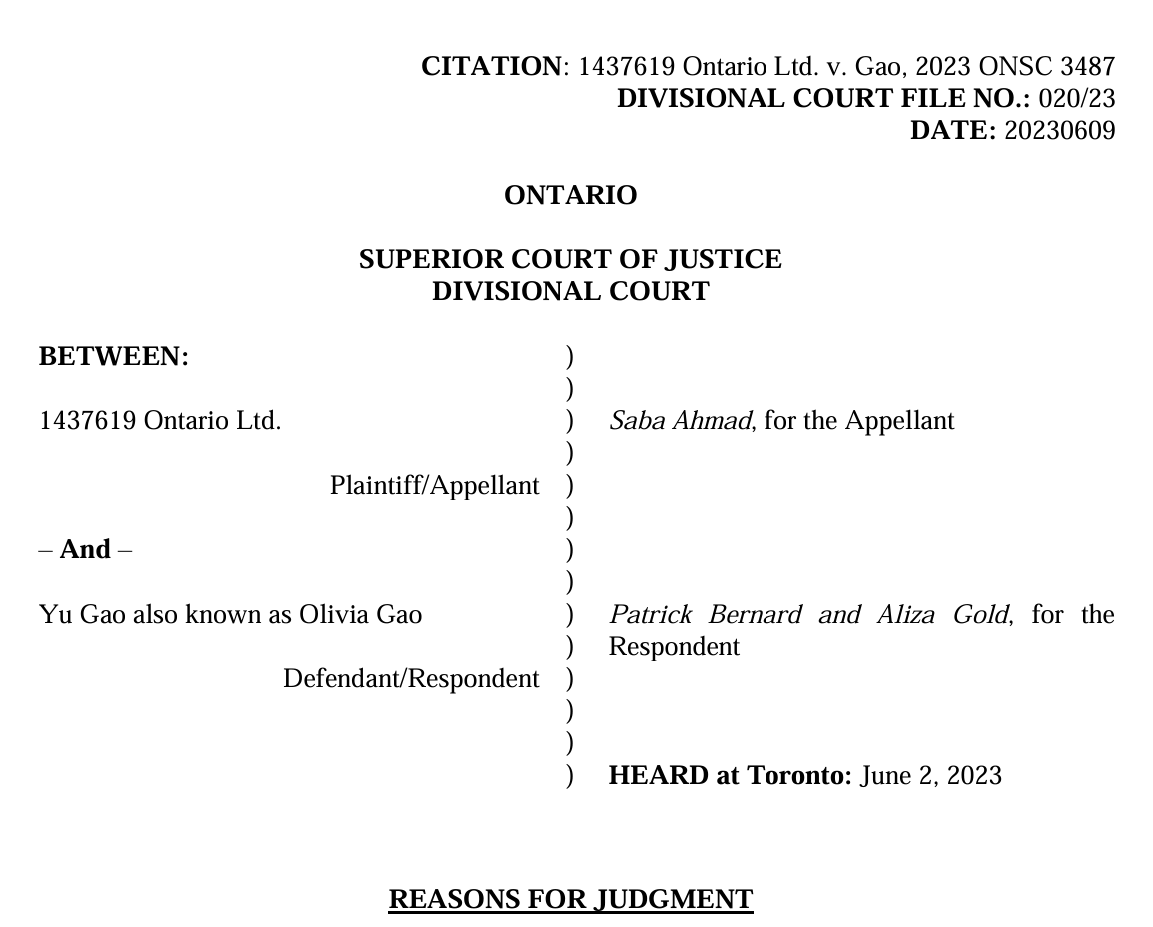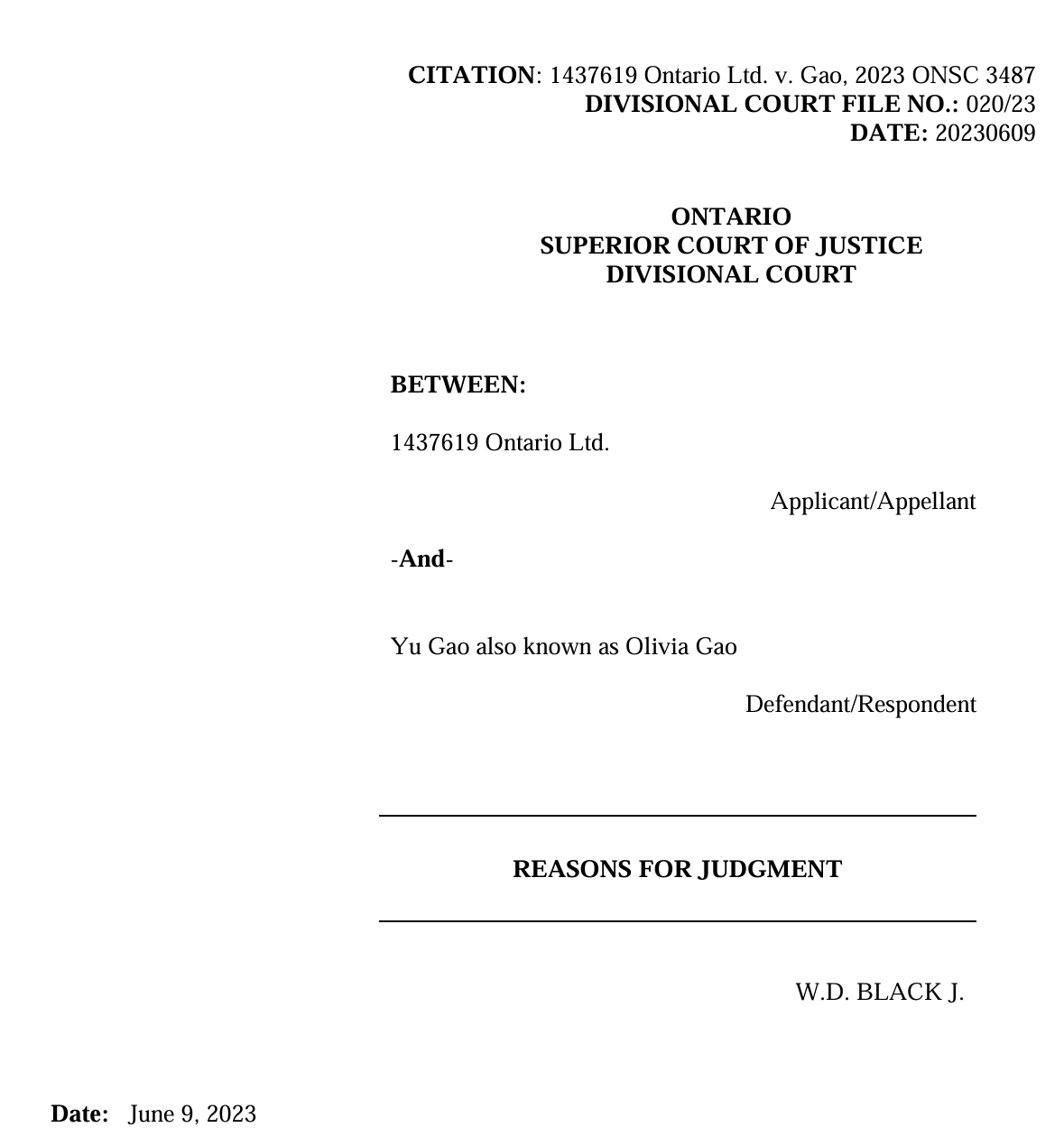
BLACK J.
Overview
[1] The appellant appeals from the decision of Deputy Judge Twohig of the Toronto Small Claims Court dated December 5, 2022, with oral reasons given that day.
[2] The judgment from which the appeal is brought awarded the appellant $8,400.00 for rental arrears owed by the respondent, and awarded the respondent $3,000.00 in costs.
[3] The appellant submits that the Deputy Judge erred by:
- Applying the two-year limitation period under the Limitations Act, S.O. 2002, c. 24 to the claim rather than the six-year limitation period under s. 17 of the Real Property Limitations Act, R.S.O. 1990, c. L.15 (RPLA);
- Implicitly finding that the respondent was severally (rather than jointly) liable for the rent claimed, and thereby reducing the amount awarded notwithstanding the respondent’s concession about the amount to be paid in the event the Deputy Judge found in favour of the Appellant;
- Awarding costs to the respondent in circumstances in which the Appellant was the successful party at trial.
Jurisdiction for the Appeal
[4] This court has jurisdiction to hear an appeal from a final order of the Small Claims Court pursuant to s. 31 of the Courts of Justice Act, R.S.O. 1990, c. C.43 and r. 61.04 of the Rules of Civil Procedure, R.R.O. 1990, Reg. 194.
The Standard of Review
[5] Both parties agree that the question of which limitation period to apply is a pure question of law, reviewable on the standard of correctness.
The Competing Limitation Periods
[6] The central issue as to which of the two limitation periods applies has been considered in a handful of cases, some of which are discussed below. It appears that there is some confusion and uncertainty in this context arising from the historical origins and meaning(s) of the word “rent”. In addition, it appears that the debate – between the two-year limitation under the Limitations Act and the six-year limitation under the RPLA – has not been specifically joined in any case regarding rental arrears in the residential tenancy setting.
[7] The starting point for the analysis is s. 2(1)(a) of the Limitations Act, which says that:
This Act applies to claims pursued in court proceedings other than,
- proceedings to which the Real Property Limitations Act applies.
[8] The contentious issue in these cases, then, is to determine the limited subset of claims to which the RPLA applies (as opposed to the Limitations Act).
The Appellant’s Argument
A. The Language of RPLA s.17
[9] The appellant relies on the plain wording of s. 17 of the RPLA and on certain cases that have interpreted and applied the limitations provisions at issue which, it argues, establish that the applicable limitation period in this case is the six-year RPLA provision. The relevant part of s.17 says:
[10] Stripping away the historical vestiges in the language, the appellant argues that the relevant language is that “no arrears of rent…shall be recovered by…action…but within six years next after the [rent] has become due,” establishing a six-year limitation on claims for arrears of rent.
B. Discussion of Relevant Cases
[11] Consistent with this interpretation, the appellant points to Perell J.’s decision in Standard Condominium Corporation No. 1487 v. Market Lofts Inc., 2015 ONSC 1067, 53 R.P.R. (5th) 67. It relies on the distinction His Honour draws in that case between a “rent charge” and “arrears” and His Honour’s observation that claims for “rent as between a landlord and tenant” are subject to the six-year period under s. 17 of the RPLA.
[12] In drawing this distinction and reaching this conclusion, Perell J. in turn cites and relies on the decision of Mew J. in Pickering Square v. Trillium College Inc., 2014 ONSC 2629, 44 R.P.R. (5th) 251, aff’d 2016 ONCA 179, 64 R.P.R. (5th) 175, on which the appellant also relies. Justice Mew undertook a thoroughgoing and helpful discussion of the historical meaning of the word “rent”. His Honour noted and emphasized a historical distinction between “rent charge”, meaning “an affirmative obligation on an owner of land, secured by a charge against the land, to pay a periodic sum of money to another person” and “rent reserved (also called ‘rent service’),” being an “amount payable under a lease between a landlord and a tenant for the exclusive possession of land…”.
[13] Having traced and explained this historical distinction, Mew J. found, at para. 36, that the six-year limitation period under s. 17 of the RPLA arises in relation to the “rent reserved” concept, and applies to claims for rent, meaning “the payment due under a lease between a tenant and landlord as compensation for the use of land or premises.” In the case before him, Mew J. found that the landlord’s claim under a provision of the lease requiring constant occupation and use of the premises constituted a claim for damages rather than rent, such that the RPLA limitation was not engaged.
[14] Justice Mew noted that the RPLA limitation applies only to “true rent claims” and that “the word ‘rent’ in the RPLA is ‘not an empty vessel that parties may fill at their discretion’.”
[15] The Court of Appeal for Ontario affirmed Mew J.’s decision but did not discuss His Honour’s formulation of “rent” for purposes of s. 17 of the RPLA.
[16] The appellant notes that such cases as 2373322 Ontario Inc. v. Nolis, 2017 ONSC 3163, 383 C.R.R. (2d) 142 and Stonequest Management Inc. v. Andritz va Tech Hydro Limited, 2019 ONSC 3273, have since followed Mew J.’s categorization of claims to which the RPLA six-year limitation applies.
[17] More recently, in a case to which both parties referred in argument, the Court of Appeal for Ontario in Northwinds Brewery Ltd. v. Caralyse Inc., 2023 ONCA 17, specifically affirmed
Mew J.’s determination in Pickering Square that s. 17(1) of the RPLA applies to rent arrears, and that “rent” has an “objective meaning under the RPLA” and “does not depend on how rent is defined by the parties in their lease”.
[18] I note here that it is difficult to conceive of the arrears at issue here as anything other than rent. This is not a case of a party attempting to disguise or stretch non-rent payments to characterize such payments as rent. Rather, in my view, the arrears in question are plainly and inescapably rent.
The Respondent’s Argument
[19] The respondent argues that the Deputy Judge appropriately held that the RPLA does not apply to claims for “breach of contract” and specifically does not apply to collecting “arrears of rent” in a residential tenancy situation.
[20] She maintains that the RPLA limitation only applies, or has “only been referenced when dealing with disputes where the title of real property is at issue”.
Analysis
[21] It appears to me that the respondent does not recognize or maintain the distinction that Mew J. in Pickering Square and Perell J. in Market Lofts have drawn between rent originating from “rent charge” and from “rent service”, respectively.
[22] In particular, the respondent does not, in her argument, address the clear statement by Perell J. in Market Lofts that claims for “rent as between a landlord and tenant” are subject to the six-year limitation under s. 17 of the RPLA, nor with the plain language of s. 17 itself confirming that the provision governs claims for “arrears of rent”.
[23] The respondent focuses instead on the passages in Perell J.’s decision in Market Lofts in which His Honour determines that a “rent charge” (explained in Pickering Square as meaning an obligation on a landowner to pay a periodic sum to another person and not involving a landlord-tenant relationship), if contractual in nature, is governed by the two-year limitation period under the Limitations Act.
[24] In my view, while apt, these passages of Perell J.’s discussion have no bearing on the matter at issue in this appeal. Rather, it is the other thread of His Honour’s discussion, specifically confirming that claims for “rent as between a landlord and a tenant” are covered by s. 17 of the RPLA, that pertains to the case before me.
[25] The respondent also argues that the RPLA limitation does not apply to claims for breach of contract at all, and that the claims for rental arrears before me are in the nature of a breach of contract claim, such that the RPLA limitation is ousted. In my view, this would render nonsensical the various observations in the cases above that s. 17 of the RPLA applies to arrears of rent. That is, the landlord-tenant relationship is by its nature contractual. It is only contractual claims that seek something other than rent, or attempt to dress up non-rent claims as claims for rent, that fall under the two-year Limitations Act provision. Genuine rent claims remain subject to the RPLA limitation.
The Deputy Judge’s Discussion of the Competing Limitations
[26] The Deputy Judge’s analysis of the question of which limitation period to apply, the two-year Limitation Act provision or the six-year limitation under s. 17 of the RPLA, did not explicitly consider the language of s. 17 or the case law set out above in which this question has been addressed.
[27] Rather, the Deputy Judge’s discussion of the rationale for applying the two-year limitation under the Limitation Act is set out in a single paragraph of his decision (at page 131), as follows:
I find that the Real Property Limitations Act has no applicability to this set of circumstances. The review and uniformity enacted by the Limitations Act of Ontario in 2002, was intended to bring uniformity to the law. That was confusing, that was very, very difficult for the parties to understand. So a unified period of two years applies if this Court has jurisdiction, which I have already indicated it does.
[28] It is undoubtedly the case that an overarching goal of the Limitations Act was to bring uniformity and relative simplicity to the application of limitation periods. It appears, however, that the Deputy Judge did not address s. 2(1)(a) of the Limitations Act, carving out from claims to which the Limitations Act applies “proceedings to which the Real Property Limitations Act applies.” Nor did he discuss any of the case law where the question of which limitation period applies in which circumstances are extensively addressed. This lack of reasons means that I am left without insight as to how the Deputy Judge arrived at his conclusion.
Conclusion re Applicable Limitation
[29] For the reasons set out above, I find the Deputy Judge erred in law, and that the six-year limitation under s. 17 of the RPLA applies to the claim in this case.
[30] This finding subsumes the second issue in the appeal. That is, given my conclusion that the six-year limitation applies, the Appellant’s full claim of $21,600.00, dating back to October of 2016 remains intact and is not foreclosed or attenuated by a limitation.
Respondent’s Suggested Deduction from the Total
[31] The respondent argues that I should nonetheless deduct from that amount an amount equivalent to four months of rent, as did the Deputy Judge.
[32] I decline to do so. The spread sheet in evidence purporting to show that there was no claim advanced for certain months in early 2018 does not clearly do so, and in my view, it is far from clear that first and last month’s rent should be deducted from this particular claim (the respondent’s co-tenant remains as a tenant in the unit at issue). The parties appear to have agreed before the Deputy Judge that if the six-year limitation applied, the amount owing would be 18 months at $1,200.00 per month, being $21,600.00. I see no reason to depart from that agreement.
Costs Below and of the Appeal
[33] Similarly, it follows that, given its entitlement to the full amount of its claim, there can be no doubt that the Appellant is the successful party here, and entitled to its costs.
[34] I have misgivings about the manner in which the Deputy Judge gave effect to the respondent’s offer to settle – described as being in an amount of $10,000 – in making his determination about costs. Again, however, the appellant’s entitlement to the full amount of its claim means that the respondent’s offer, being less than half the amount of the judgment in favour of the appellant, no longer has any potential impact in reducing the appellant’s costs, let alone in somehow justifying an award of costs in favour of the tenant.
[35] In conclusion, I grant the appeal, and increase the amount of the judgment from $8,400.00 to $21,600.
[36] I find that the appellant is entitled to its costs below, and to its costs of this appeal. The Deputy Judge awarded $3,000.00 for the costs of the trial before him, and, while those costs are now payable to the appellant, I do not interfere with the amount awarded.
[37] The appellant seeks costs of the appeal in the amount of $11,243.00 on a full indemnity basis or $9,548.00 on a partial indemnity basis.
[38] The respondent says costs of the appeal should be on a partial indemnity basis, and says that the amount should be $6,000.00.
[39] I agree that partial indemnity is the appropriate scale. The appellant alleges misconduct on the part of the respondent leading to a multiplicity of proceedings. While there were various attendances before other tribunals, I am not able to determine that the respondent is responsible or blameworthy for these detours, nor do I see any other conduct that should attract costs on a higher scale.
[40] I fix the costs of the appeal at $8,000.00 on a partial indemnity basis, and order the respondent to pay those costs to the appellant in addition to the costs below.

Date: June 9, 2023



